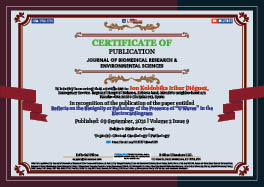Iribar Dieguez IK, Lucas Cabornero J and Lopetegui Cano M
Volume2-Issue9
Dates: Received: 2021-09-01 | Accepted: 2021-09-09 | Published: 2021-09-09
Pages: 777-778
Abstract
We present the electrocardiogram (Figure 1) of a 14-year-old man in which, without related pathology, and incidentally in the context of a consultation for another reason, a U wave was detected in precordial leads V3 and V4. Does that U wave have pathological significance?
FullText HTML
FullText PDF
DOI: 10.37871/jbres1309
Certificate of Publication

Copyright
© 2021 Iribar Dieguez IK, et al. Distributed under Creative Commons CC-BY 4.0
How to cite this article
Iríbar Diéguez IK, Lucas Cabornero J, Lopetegui Caño M. Reflects on the Benignity or Pathology of the Presence of “U Waves” in the Electrocardiogram. J Biomed Res Environ Sci. 2021 Sept 09; 2(9): 777-778. doi: 10.37871/jbres1309, Article ID: JBRES1309, Available at: https://www.jelsciences.com/articles/jbres1309.pdf
Subject area(s)
References
- Mas Casals A, Lobos Bejarano JM. ¿A qué puede corresponder cada alteración de una onda, complejo o intervalo? AMF 2012;8(10):597-600.
- Pérez-Lescure Picarzo J. Guía rápida para la lectura sistemática del ECG pediátrico. Rev Pediatr Aten Primaria 2006;8:319-326. https://bit.ly/3jY3za0
- Millán JJ. Ondas “U” en electrocardiogramas. 2016. https://bit.ly/3hj0BLQ.
- Kishida H, Cole JS, Surawicz B. Negative U wave: the clinical significance and the consideration of pathogenesis. In: Rosenbaum MB, Elizari MV (eds). Frontiers of Cardiac Electrophysiology. Desarrollos en Medicina Cardiovascular, Springer. Dordrecht. 1983;19:100-119. Doi: 10.1007/978-94-009-6781-65
- Dr Smith, in Dr Smith ECG blog. 2018. https://bit.ly/3yW835A.
- Pérez Riera AR, Ferreira C, Filho CF, Ferreira M, Meneghini A, Uchida AH, Schapachnik E, Dubner S, Zhang L. The enigmatic sixth wave of the electrocardiogram: the U wave. Cardiol J. 2008;15(5):408-21. PMID: 18810715.






























































